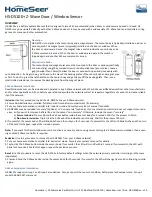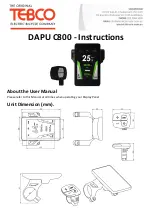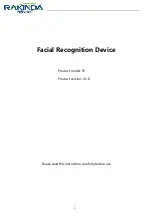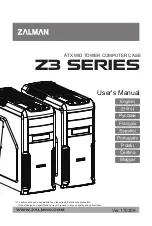
HomeSeer | 10 Commerce Park North, Unit 10 | Bedford, NH 03110 | HomeSeer.com | Doc: HS-DS100-en-v1.0
HS-DS100+ Z-Wave Door / Window Sensor
Operation
HS-DS100+ is comprised of a sensor body and a magnet piece. The sensor body is (typically) installed on a door or
window jamb. The magnet piece is (typically) installed on the door or window. When
the door or window are closed, the magnet trips a switch inside the sensor body and a
Z-Wave command is issued. When the door or window are opened, the switch is
tripped again and another Z-Wave command is issued.
Physical Installation
The sensor body and magnet piece must be mounted to the door or window (vertically
or horizontally) using the provided screws or double-stick tape (your choice). Leave a
gap (no wider than 10mm) to allow the door or window to open and close easily with-
out obstruction. If using screws, you’ll have to the mount the backing plates of the sensor body and magnet piec-
es first. To do this, press the latch button on the sensor body and gently pry off the backing plate. Then, use a
small slotted screwdriver to remove the backing plate from the magnet piece.
Z-Wave Network Installation
Door/Window Sensor can be included and operated in any Z-Wave network with other Z-Wave certified devices from other manufacturers
and/or other applications. All non-battery operated nodes within the network will act as repeaters regardless of vendor to increase reliabil-
ity of the network.
Inclusion (Use this procedure to add the HS-DS100+ to your Z-Wave network).
1. Ensure AAA batteries are installed. Pull plastic tab from battery compartment (if necessary)
2. Put your home automation controller into ‘inclusion’ mode. Consult your system’s manual for details.
3. HS-DS100+ may be included “securely” (option a) or “non-securely” (option b). If your automation controller does not support secure de-
vices, or if you wish to improve battery life, add the sensor “non-securely”. Otherwise, include the sensor “securely”
a) Secure inclusion: Press and hold the Z-Wave button inside the sensor body for 3 seconds. Wait for the process to finish.
b) Non-Secure inclusion: Triple-click the Z-Wave button inside the sensor body. Wait for the process to finish.
4. If successful, the sensor body LED will blink briefly and then stay on for 3 seconds. If unsuccessful, the LED with blink briefly and then turn
off. Should this happen, repeat the inclusion process.
Note: If you want this Door/window sensor to function as a security device using secure/encrypted Z-Wave communications, then a secu-
rity enabled Z-Wave controller is required.
Exclusion (Use this procedure to remove the HS-DS100+ from your Z-Wave network).
1. Put your home automation controller into ‘exclusion’ mode. Consult your system’s manual for details.
2. Triple-click the Z-Wave button inside the sensor body. If successful, the LED will turn off within 1 second. If unsuccessful, the LED with
blink for 5 seconds. Should this happen, repeat the exclusion process.
Reset (Use this procedure to reset the HS-DS100+ to factory default settings when the network primary controller is missing or otherwise
inoperable).
1. Press and hold the Z-Wave button inside the sensor body for 20 seconds. If successful, the LED will change from solid, to blinking, to solid
again.
Z-Wave Association Information
HS-DS100+ supports Group 1 and Group 2 associations. Group 1 reports the sensor’s condition, battery level and tamper state. Group 2
sends the BASIC SET command.
OVERVIEW
HS-DS100+ is a battery operated sensor that is designed to issue Z-Wave commands when doors or windows are opened or closed. HS-
DS100+ may be associated directly with other Z-Wave devices or it may be used with a wide variety of Z-Wave hubs and controllers to trig-
ger events, scenes and other automations.




















